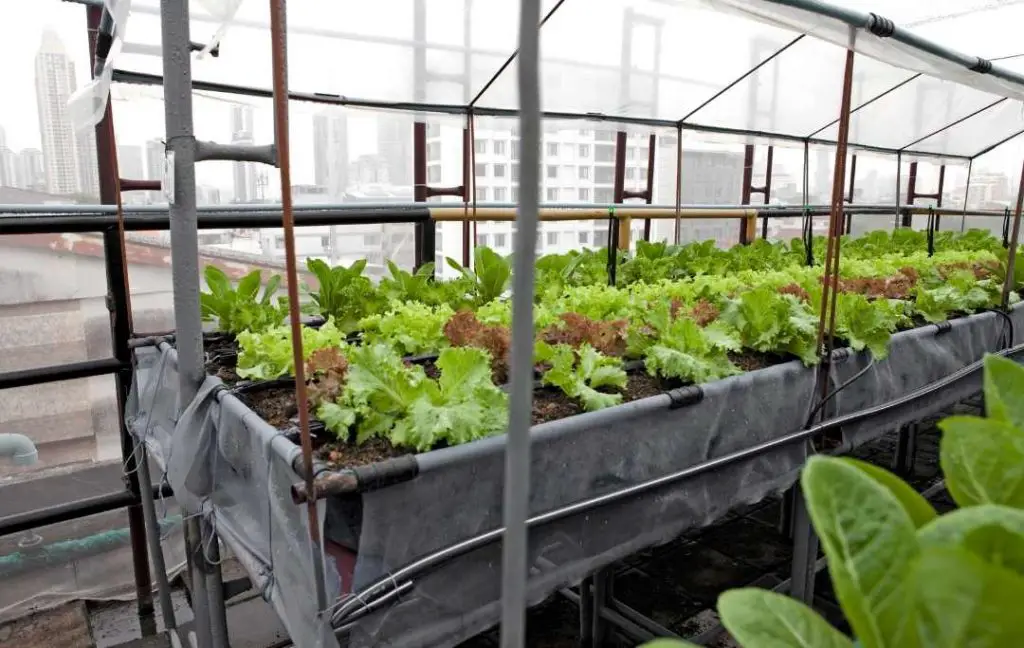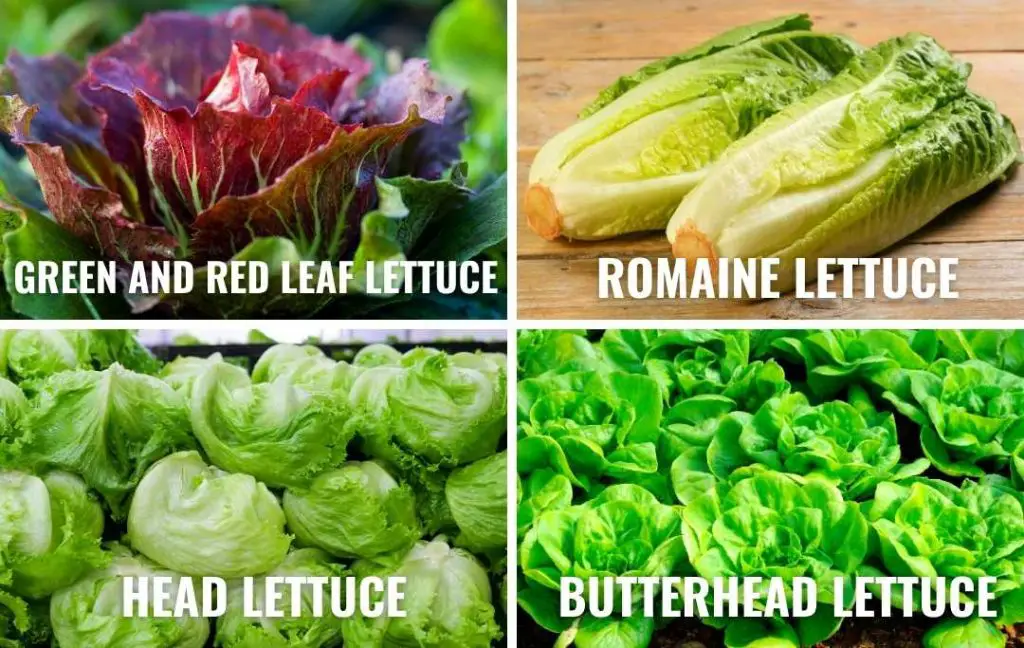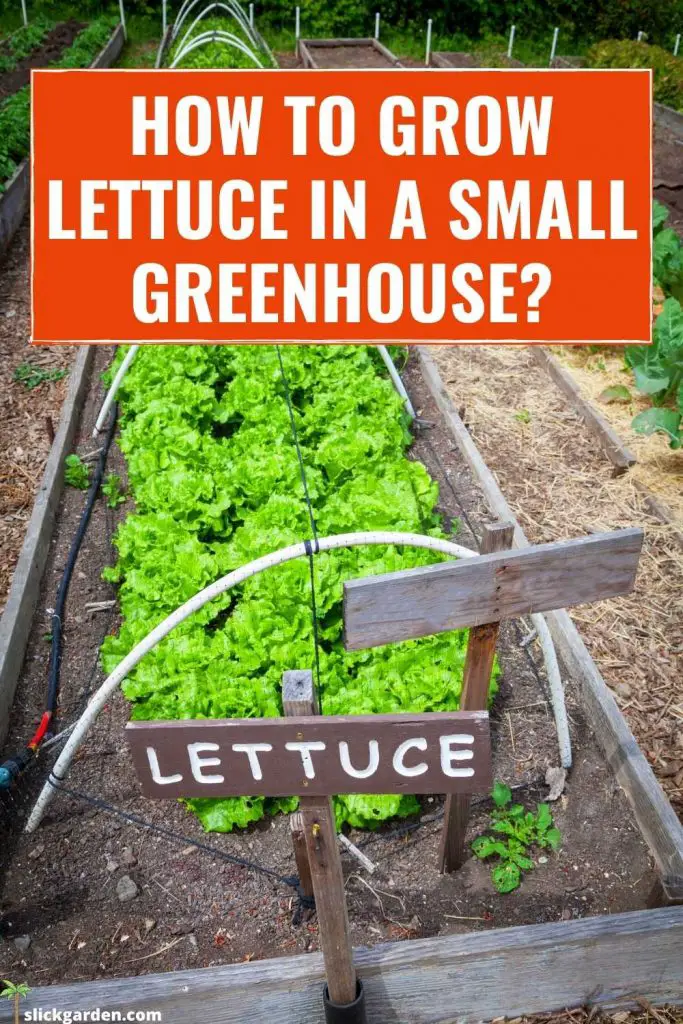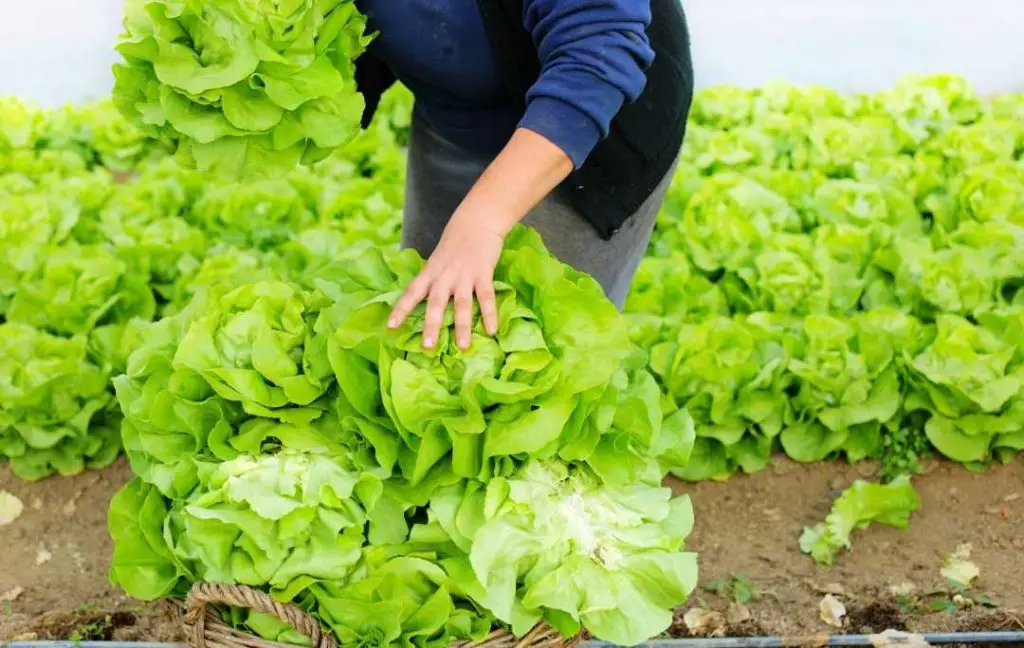Lettuce is an ideal salad vegetable that likes cool weather. You will get many nutrients for your healthy diet from lettuce like folate, manganese, vitamins, and fiber. Your soups and sandwiches will become tastier after its addition.
It is easy to grow annual vegetables that mature in 30 days. In this article, we will discuss how to grow lettuce in a greenhouse. In winter, you can easily grow lettuce in a greenhouse.
For growing lettuce, you don’t need to heat your greenhouse because it likes a cool environment. If you are living in an area that is frost-free then a greenhouse is necessary.

Besides providing heat to your plants, it will also provide extra protection and there is no danger of weeds. It is important to know that during spring, summer, and fall months, a greenhouse is a hot place for this cool season loving crop.
WHEN TO PLANT LETTUCE IN GREENHOUSE?
The cold lover vegetable lettuce can be planted in spring but the time of planting depends upon the variety you are growing in the greenhouse. It likes the temperature between 40 to 85 degrees Fahrenheit.
If you want to avoid summer then you should plant it before the warm summer temperature starts. The fall lettuce can be planted in late summer and you will get the matured vegetable when the fall starts.
Lettuce can be transplanted in the spring after passing the last frost date. But you can also grow earlier because the greenhouse will provide better growing conditions and adequate protection against the harsh weather.
Read More: HOW TO BUILD A SMALL GREENHOUSE FOR VEGETABLES
HOW TO PLANT LETTUCE IN GREENHOUSE?
If you are planning to sow lettuce seeds in the ground then start planting as soon as the soil is workable. Due to adequate protection being provided by the greenhouse so you can start planting without waiting for the last spring frost date.
Lettuce can easily be grown from seeds. These seeds are very small so the depth needed to plant them is only ¼ to ½ niche. For a traditional look, you should grow lettuce in a row. There should be a distance of 12 to 18 inches between two rows and sow 10 seeds per foot.
Head lettuce can be transplanted in rows 12 to 18 inches apart, the distance between each plant should be 10 to 12 inches. If you stagger the lettuce in the greenhouse then you will get more plants because of creating more formal rows in a limited space. Thin lettuce seedlings can be used as fresh greens to enhance the taste of your favorite dishes.
Buy Greenhouse For Your Garden
DIFFERENT TYPES OF LETTUCE

There are four types that are generally grown like romaine, butterhead, head lettuce, and loose-leaf lettuce. The needs and requirements of every type are different.
GREEN AND RED LEAF LETTUCE
This is the easiest variety to grow for beginners. Many people think that there is a difference between green and red leaf lettuce. It is a misconception both varieties are the same.
Leaf lettuce can be grown in rows and you can easily get 2 to 3 harvests from one planting. Red Sails, Tango, and Slobolt are popular cultivars.
ROMAINE LETTUCE
The other name of Romaine lettuce is cos, you can get tall, tight, and thick bundles of sweet letters leaves from this type. After 60 to 80 days this type of lettuce will reach up to 20 inches, this is the time to harvest it. The common cultivars are Green Towers, Valley heart, and Red-Eyes Cos.
HEAD LETTUCE
The other name of head lettuce is Iceberg. The salad lovers always like to grow this variety of lettuce in their garden or raised bed. Head lettuce can easily be planted indoors easily in spring after the passing of the last frost.
It is important to know that this variety needs more care than others. Always plant head lettuce in the fall because warm weather is not suitable for it. The common and great head cultivators are Ithaca, Great Lakes, and Crispivo.
BUTTERHEAD LETTUCE
From this variety, you will get tender lettuce leaves that have tightly folded heads. The reason for this name is its flavor which is like subtle butter.
When you add this variety to your salad then it will give a sweet touch. There is a delicate white color found in the middle leaves of this variety. The most common cultivars are Try Eramosa, Esmeralda, or Nancy.
Read More: 20 DIY GREENHOUSE PLANS – Cheap Greenhouse Ideas
WATER REQUIREMENTS FOR LETTUCE
It is not a deep-rooted plant. Leaf growth of lettuce is more important as compared to the root development. Lettuce needs to be regular and frequent water but doesn’t overwater it.
Light watering Is sufficient for the moisture of the soil. Overwatering will spread diseases and stop the growth of healthy lettuce and as a result, it will rot.
Your lettuce bed needs water once a week or whenever you see that the soil is getting dry 1 to 2 inches down. With the help of your finger, you can easily check the dryness of the soil.
If you are growing your plants in a greenhouse then the greenhouse will get hotter very easily and your soil will dry very rapidly. In the case of warm weather, you should check the soil on a daily basis.
Lettuce is a shallow-rooted vegetable and its roots develop very quickly that’s why it needs lots of water to produce tender leaves.
Read More: Easiest Vegetables To Grow In A Mini Or Small Greenhouse
SUNLIGHT
As you know that sunlight is very important for the growth of any plant. Lettuce is a plant that is an important ingredient of a healthy salad. It means that it makes food for you.
For the food production of plants, photosynthesis is an important process that takes place in sunlight. 6 hours of sunlight is essential for healthy lettuce growth, so select the location which will get maximum sunlight, so your plant will not rot.
Buy Greenhouse For Your Garden
SOIL AMENDMENTS
Soil is very important because it provides all the basic nutrients to your plant. Lettuce like loose, cool, and well-drained soil. If you add compost and manure then it will increase drainage, so try to provide all the essential nutrients and increase the growing conditions of lettuce.
Soil is a growing medium, you can check the fertility of the soil by using a testing kit. The pH of your soil must be 6.0 because lettuce is very sensitive.
If you are growing your lettuce in raised beds then you should not be worried because you can maintain the fertility of soil within the raised bed. First, you should fill the raised bed with loamy topsoil.
Compost is important to provide nutrients to your plants, so you have to leave one to two inches of space on the top of the bed for the adding of compost.
After filling with the compost, mix the soil with the compost, with the help of a garden fork. Now it needs a good quality fertilizer that will provide essential nitrogen to your plants. If you are planting in an 8-square- foot raised bed then it will need 12 tablespoons of balanced fertilizer.

FERTILIZING MIDSEASON
You added the fertilizer when you prepared your garden bed, for your lettuce plant. but it doesn’t mean that your plant will not need more fertilizer during the growing season.
At least after three weeks, you should add one tablespoon of balanced fertilizer, by this addition your plant will get a boost. Just Sprinkle the fertilizer on the top of your soil after this work. You should water the soil so it will be 5 to 6 inches deep.
Read More: 15 SIMPLE AND INEXPENSIVE HOMEMADE FERTILIZERS
TEMPERATURE OF GREENHOUSE
The temperature of the greenhouse should be 50 to 70 degrees Fahrenheit during the day. you know that the temperature of the greenhouse will warm very rapidly due to this reason you should open the door so that the fresh air can get inside and reduce the temperature of the greenhouse.
At night the temperature of the greenhouse should be between 45 F and 55 F. As you know that lettuce loves cold temperature, for this purpose try to keep the soil moist and make it possible that the air will circulate inside the greenhouse during the warm spells.
Buy Greenhouse For Your Garden
TIPS AND TRICKS
The following tips are very useful while you are growing your lettuce plants in the greenhouse.
- By using artificial methods, you can provide heating and cooling according to the need of your lettuce plant throughout the year.
- Many greenhouses have ventilation systems, in this way, you can adjust air circulation according to the needs of your plant, and also you can maintain the temperature.
- Although lettuce likes cold weather, avoid exposing them to the snow because it will kill them.
- Try to plant garlic and chives near the lettuce plants because it will help you to control aphids.
- Electricity is very important in your greenhouse because many times you need artificial heat and light sources for your plants.
COMMON PROBLEMS WHILE GROWING LETTUCE PLANTS
Like every plant lettuce also faces many problems like attacks of many pests such as earwigs, cutworms, and aphids. Your lettuce patch can easily be destroyed by aphids.
This is the reason for spreading disease in your plant and creating mold issues. You can’t control aphids easily but with the help of lady beetles or applying soap and neem oil, you can get rid of this problem.
Some insects like snails, slugs, and caterpillars also like lettuce. These pests are very common and you should do something to protect your plants like traps, organic bait, and handpicking.
When you see that the leaves of lettuce are beginning to brown and curl. It means that it is suffering from a physiological condition which is known as tip burn. This problem will start when the moisture is not consistent.
The solution to this problem is to simply trim the browned lettuce and try to provide consistent water, according to schedule, to your lettuce plant.
You should check the lettuce every day because the leaves of adult lettuce will become bitter and woody. Preventing your favorite salad vegetable from rot you should check it daily.
In the daytime as the temperature rises due to the sunlight then you should cover your lettuce with a shade cloth which will prevent the plant’s tendency to dry.
HARVEST

You will not face any difficulty harvesting lettuce because it is very easy to pick. The maturity time of most of the lettuce can be 30 to 70 days after planting.
The answer to the question; when to harvest lettuce depends upon the variety which you planted. When lettuce reaches the exact size you want it then it is the best time to harvest it.
Always try to harvest lettuce in the morning so it will give you the best flavor. You can also cut the entire bundle at the ground level like romaine, butterhead, and head lettuce.
